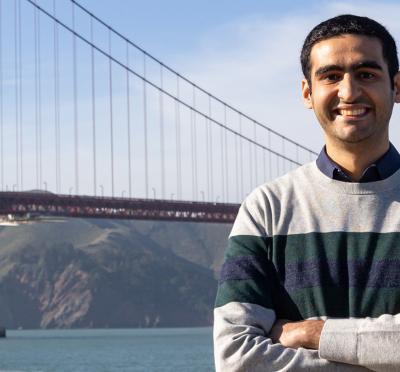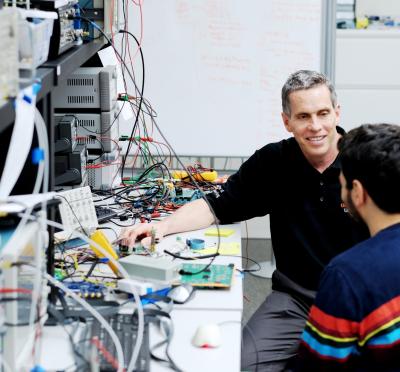
Four faculty in the Oregon State University College of Engineering have received prestigious early-career investigator awards from the National Science Foundation and the Office of Naval Research. Erica Fischer, Kelsey Stoerzinger, and Rebecca Hutchinson are the recipients of the Faculty Early Career Development, or CAREER, awards from the NSF. Meagan Wengrove is the recipient of a Young Investigator Program award from the ONR.
The grants cover a wide array of engineering projects: studying the use of mass timber for building construction; researching the safe production of hydrogen gas from seawater; improving the species distribution models used by ecologists and natural resource managers; and using fiber optic cables on the ocean floor as early warning systems for communities in harm’s way from earthquakes, tsunamis, and dangerous waves.
This is the first year in the college’s history that all of the NSF and ONR early-career investigator awards have gone to female faculty. In the 30 years prior, only 10 of the 59 College of Engineering faculty who received early-career awards were women.

“I’m delighted by the early career success of these faculty, but not surprised,” said Scott Ashford, Kearney Dean of Engineering at Oregon State. “Several years ago, the College of Engineering began creating a more inclusive environment in support of female engineers by taking a deep look at the root causes of longstanding barriers and implementing programs to achieve the desired changes in faculty recruitment, promotion and tenure, and professional development. And now we’re seeing the fruits of these changes.”
According to the American Society for Engineering Education, Oregon State’s College of Engineering ranks second nationally among land-grant universities for percentage of tenured or tenure-track faculty who are women and third among the nation’s 94 public R1 universities. These rankings played a role in the College of Engineering being selected by ASEE as an “exemplar” recipient of a Bronze Award in the first year of the ASEE Diversity Recognition Program, the highest recognition offered in the program’s inaugural year.

Fischer, assistant professor of civil and construction engineering, was selected for her proposal to create new technologies for the mass timber modular construction of buildings. The building construction industry is primed for a major change to improve efficiency, she said, noting that construction has been done the same way for more than 100 years.
“Almost every major U.S. city is experiencing a housing crisis, and modular construction addresses these housing shortages in addition to improving job site safety, increasing speed of construction and lowering construction costs,” Fischer said. “Enabling mass timber to be used for modular building construction is also really beneficial to Oregon’s economy, which has made significant investments in mass timber production, manufacturing and research.”
Fischer will use her $560,000 award to develop innovative technologies for changing how buildings are designed, manufactured and assembled — specifically, technologies that enable the use of mass timber for modular construction buildings with a range of lateral force resisting systems, in regions with high earthquake risk or high wind loads.
“We will study the connections of members within mass timber modular buildings and the relationship between the rigidity of these connections and overall structural behavior,” she said.
Stoerzinger, assistant professor of chemical engineering, was chosen for her proposal to study how to split seawater into hydrogen and oxygen gas while avoiding undesirable, chloride-containing byproducts. Hydrogen has many scientific, industrial, and energy-related roles, including in fuel cells for cars.
“Renewable electricity can drive chemical reactions, including the generation of hydrogen from water,” Stoerzinger said. “This stores electrical energy in a chemical fuel that can be transported and used on demand. Seawater is an abundant water resource, but electrochemical hydrogen generation can also generate harmful byproducts from seawater salts that pose environmental and safety concerns.”
Stoerzinger will use her $550,000 award to design and test materials and reaction conditions that split water without creating these byproducts.

“We’ll focus on designing materials called catalysts that selectively facilitate the generation of benign oxygen gas in systems containing chloride salts,” she said. “Our work will aid the development of improved energy storage and chemical manufacturing strategies that reduce our nation’s reliance on non-renewable resources.”
Hutchinson will use her $564,000 award to tackle challenges for the machine learning methods typically used to build species distribution models, or SDMs.
“You build an SDM by correlating observations of species — are they there or not? — with environmental features,” she said. “Then you can use the model to understand why species live where they do and how likely a species is to occur at a new site. But the spatial aspects of both species and environmental data can be problematic for the machine learning currently used in the models.”
Hutchinson, an assistant professor with appointments in both engineering (computer science) and the College of Agricultural Sciences (fisheries, wildlife, conservation sciences), will research methods for lowering the potential for bias to creep into model quality estimates and for accounting for the inevitable underreporting of species during biodiversity surveys.
“To assess model quality, typically some data are held out from model building,” she said. “Then the model’s ability to predict the unseen data is used to measure its quality. With spatial data, however, randomly selecting data to hold out can lead to optimistic bias in quality estimates.

“The error introduced by underreporting can be corrected by conducting multiple observations at the same site,” she said. “Our award will support conducting these observations.”
With her $510,000 award, Wengrove, assistant professor of civil engineering, will examine the possibility that a nascent technology called distributed acoustic sensing can serve as an early warning system for events such as tsunamis, sneaker waves, and internal waves — each one potentially powerful enough to pose threats to coastal communities and marine traffic.
To test the idea, she’ll send laser pulses down fiber optic cables that rest on the seabed and which stretch up to 20 kilometers from shore. “Because the cables are made of glass, the light propagates quickly down each one,” Wengrove said. “Any disturbance — such as a wave or movement of the sea floor — that deforms the fibers, even just a tiny amount, will change the way the light signal returns to its origin. We can then detect precisely in time and space where that change occurred and how large it was.”
In theory, real-time alerts could be automatically sent out to warn communities or seagoing vessels about the potential hazard.
“There’s no other type of sensor out there that can sample as quickly and at so many locations simultaneously, and the technology is improving every day,” Wengrove said. “It’s conceivable that we could one day use fiber optic sensing with existing telecommunications cables that span entire oceans and monitor in real time events thousands of miles from shore.”



